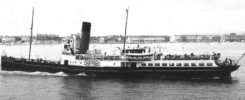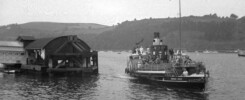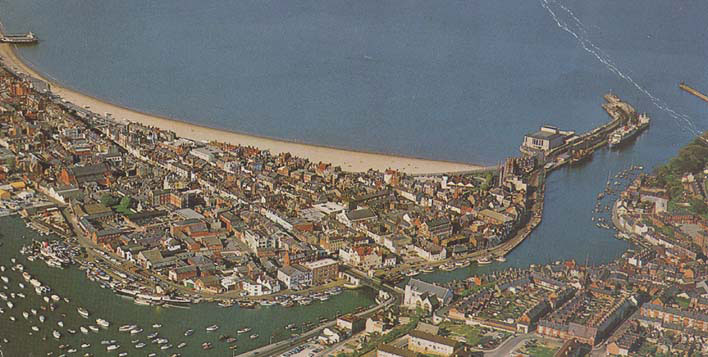
Weymouth Harbour in an aerial shot taken in April 1965 with, in the Backwater on the left, the Princess Elizabeth, with her red funnel, getting ready to go to Southampton for her annual slipping and the Embassy, with her buff funnel, outside Cosens’s workshops just returned from her slipping at the Admiralty slipway at Portland. She had been taken there and back by an Admiralty tug which had done the job berthed alongside her aft of the starboard paddle box. This meant that on the return leg when the combined tow put alongside the Weymouth Pleasure Pier port side to, to transfer the tow to the local launches, the Embassy ended up head out and was towed that way round back through the Town Bridge. I don’t recall seeing her, nor have I seen any pictures of her, berthed in the Backwater that way round at any other time in the post war period.
Further down the harbour on the right is the Channel Islands cargo boat Roebuck, laid up prior to her sale and last trip in July to the scrapyard at Queenborough and one of the Channel Islands mail-boats, either the Caesarea or Sarnia (I can’t tell them apart), newly painted with the blue/green hull plus black topped orange/red funnel embossed with the railway double arrow in white which had just been applied to the vessels of the marine division of British Railways that winter. Beyond her is one of the various Scandinavian cargo vessels chartered from time to time to augment the Channel Islands cargo service.
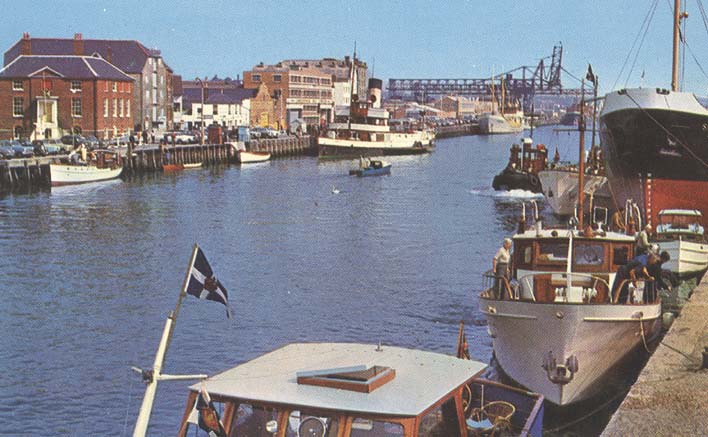
As we saw in the May POTM the Embassy left Weymouth on Saturday 5th June 1965 in thick fog for a PSPS charter around the Isle of Wight and ended that day at her summer base in Poole where she can be seen in this picture.
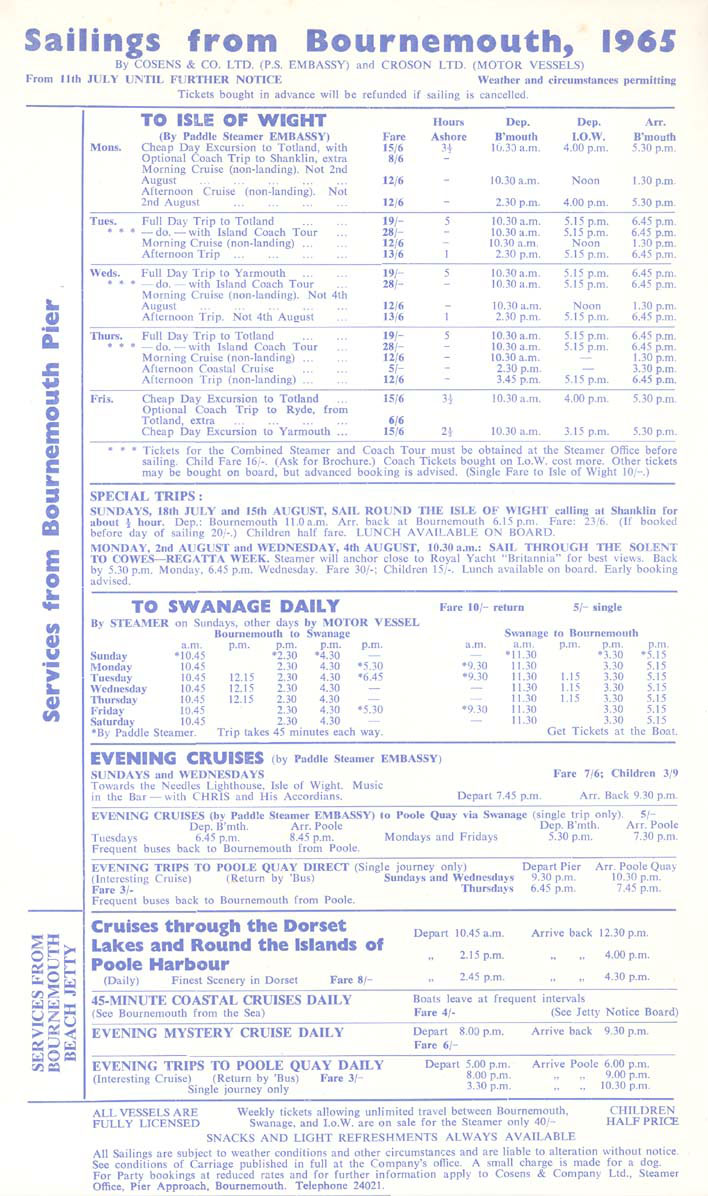
In the immediate post war period there had been at least four paddle steamers operating daily excursions from Bournemouth in the peak summer months augmented by calls from steamers from elsewhere, most particularly Weymouth, but from 1963, and for her last four seasons, the Embassy reigned at Bournemouth alone.
As you can see in the 1965 steamer notice above, her basic schedule was for a Bournemouth to Swanage ferry service on Sundays, Bournemouth (and a couple of days a week from Swanage as well) to either Totland Bay or Yarmouth, Isle of Wight Mondays to Fridays and evening cruises towards the Needles on Sundays and Wednesday with Saturdays off service at Poole.
The longer day trips to more distant and exotic destinations like Ryde, Southsea, Southampton, Shanklin and around the Isle of Wight, which had ever been a relatively minor part of the overall Bournemouth revenue, largely dropped out of the schedules from the late 1950s as the Cosens’s fleet diminished although there were still occasional longer trips for special events. For example the Embassy took passengers from Bournemouth to see the American nuclear powered submarine Nautilus at Portland on the afternoon of Sunday 17th August 1958 and the Monarch ran a special cruise to watch Princess Margaret and Anthony Armstrong Jones return to Portsmouth on the Royal Yacht Britannia on Saturday 18th June 1960.
Founded in 1959 the PSPS was active in encouraging a revival of some of these longer trips and took a series of paddle steamer charters in subsequent years to try ideas out. These met with varying degrees of success with perhaps the best result being achieved with a charter round the Isle of Wight of the Embassy on 5th July 1964 which was sold out. As a result of this, they chartered the Embassy again for another such cruise at the start of the 1965 season, as we have seen, this time starting at Weymouth. This encouraged Cosens who, in a burst of optimism, decided to put on three more round the Island trips in their own right in 1965.
They scheduled one for Sunday 4th July with a call at Shanklin which brought out a fair crowd but of the two advertised in the steamer notice above, the one on 18th July was only lightly loaded and the one on 15th August was cancelled ostensibly due to the weather although the Embassy did run that day from Bournemouth on the Swanage ferry service. A further unusual charter, this time to the Coastal Cruising Association, on 4th September from Bournemouth along the Dorset coast to Weymouth, which was a very rare passenger trip for the Embassy, was cancelled due to lack of demand.
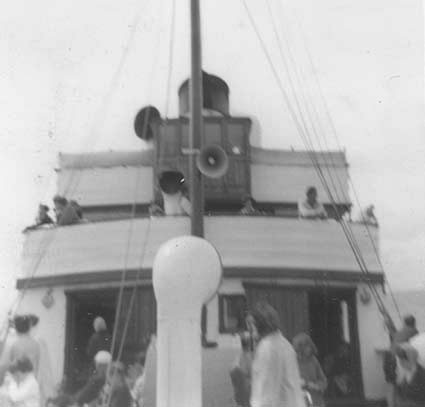
One extension to the normal routine which did continue to be advertised each summer from 1958 right up to the Embassy’s last season in 1966 was the two annual visits to Cowes Week which in 1965 were on Monday 2nd and Wednesday 4th August. Dad and I joined the Embassy at Poole on the Wednesday for a 9am departure for Bournemouth where we arrived at 10am ready for the 10.30am sailing time. A very large crowd joined but most of them disembarked at Yarmouth at 12 noon leaving only a handful aboard for that rare onward trip to Cowes.
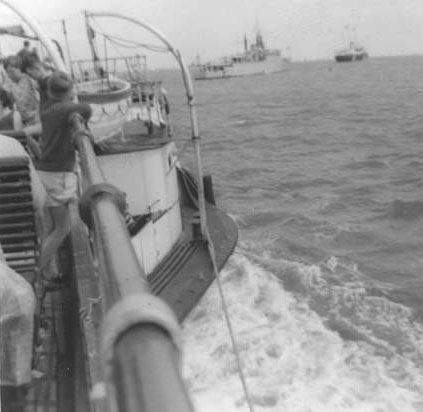
In previous years the Embassy had called at the Red Funnel West Cowes Terminal for any passengers who wanted to disembark for time ashore but this had the technical difficulties of getting the Embassy in and out of Cowes Harbour twice when it was filled with yachts none of which seemed to care a jot for keeping clear of a paddle steamer. The Embassy did have a bow rudder but this only had an effect when the ship was going so constant stops and starts made things difficult for Capt Iliffe. There was also the necessity of fitting the Cowes calls in around the Red Funnel Ferry movements on the pontoon which could and did lead to delays.
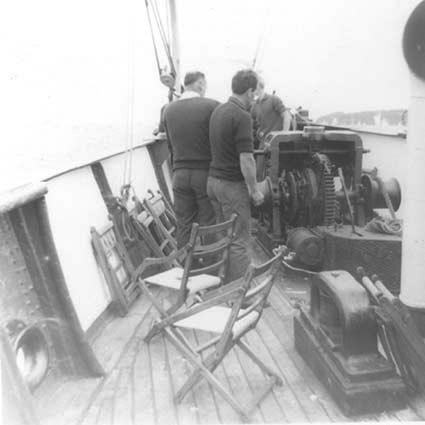
As a result, for 1965 the cruises were advertised without a call at Cowes and the Embassy anchored off instead amidst the yachts to watch the proceedings. Anchors are of course handy, not to say essential, things for getting you out of trouble particularly if you break down and they can be an aid to ship handling. But they were not generally used in the normal course of events by Cosens’s paddler steamers which, like many ships of that generation, usually stowed their anchors on deck inside the bulwarks rather than ready to drop in hawser pipes. This meant that they had to be lifted over the side by an anchor davit before being dropped and lifted back on deck afterwards, a laborious and by no means speedy procedure.
The Embassy, however, was the exception. She did carry her anchor stowed in her port hawser pipe like modern ships and therefore it was easy to drop. Take off the claws. Undo the brake and down she goes: splash, rattle, rattle, rattle.

Interestingly the Embassy’s pretty much identical sister (as built) the Monarch, ex Shanklin, had the same arrangement complete with a proper hawser pipe but was equipped with an old fashioned Fisherman’s anchor which wouldn’t fit into it so the anchor was carried on a sort of steel table on top of the bulwark forward as can be seen in this picture.
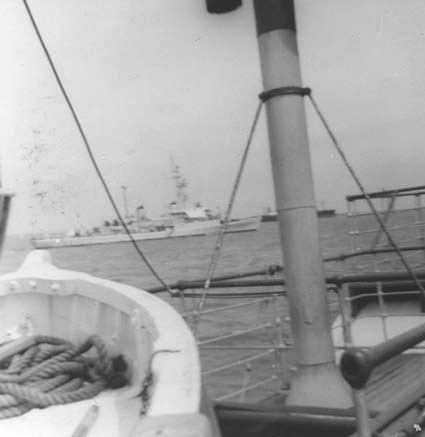
The Embassy did have a galley with a coal-fired range in the aft part of the port sponson beneath this galley chimney and it was possible to buy a hot lunch aboard and eat it in the lower dining saloon aft but of takers for this there were generally few. On the Swanage service passengers were only aboard for forty five minutes at a time and even the day trip from Bournemouth to the Isle of Wight only had a steaming time of around one and a half hours each way so with an arrival time on the Isle of Wight at 12 noon or earlier and a departure at 4pm or 5.30pm just in time to get passengers back to Bournemouth for their evening meals, there wasn’t really much of a demand.
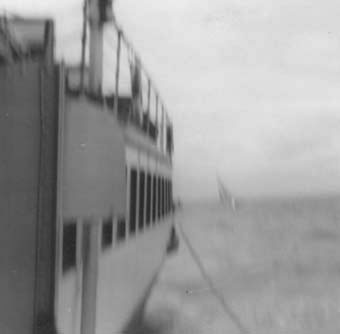
After a good view of the yachts and other vessels tearing past on the swift moving tide the anchor was weighed at 3.30pm and the Embassy set off back down the Solent arriving at Yarmouth at 4.45pm ready to load the masses for a departure at 5.15pm for Bournemouth which was reached spot on time at 6.45pm and Poole one hour later. Looking back through my notes from that era I see that the Embassy was almost an hour late back from Cowes on the trips Dad and I did in 1963 and 1964 so scrapping the call at Cowes seems to have proved beneficial for the time keeping.
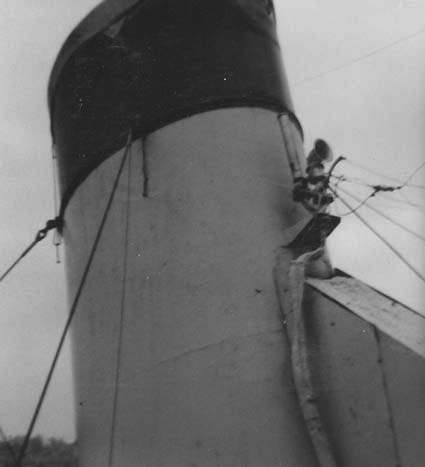
People sometimes ask about the vast ducting on the forward side of the Embassy’s massive post war funnel wondering what it did. Well, for those who don’t know, it was connected to a steam driven fan engine just abaft the wheelhouse which blew air into and up the funnel inducing a draught which sucked the products of combustion from the burning fuel oil through the furnace and boiler tubes and on out to the atmosphere above. This controlled the rate of firing in the boiler and prevented blow backs into the boiler room.
The Consul and the Emperor of India were also given this induced draught system for their boilers when they were converted from coal to oil firing after the war, the arrangement having the particular advantage that the boiler room did not have to be sealed as in a forced draught system like that on the Waverley where air is blown into the closed boiler room and can only get out by going through the furnace and up the funnel.
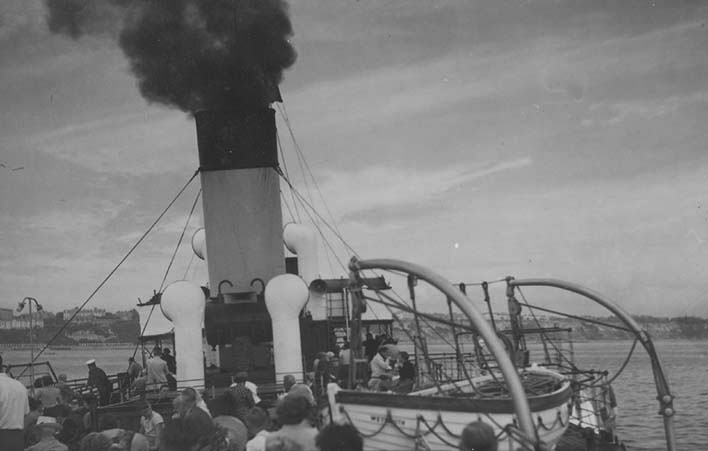
After being converted to oil firing prior to the 1947 season, the Embassy was much troubled by the production of rather too much thick black smoke which became something of a trademark and which could be seen many miles in the distance long before you could see the Embassy herself. I have a very clear recollection of looking out of my bedroom window on the afternoon the Embassy came to Portland to view the Nautilus and seeing this tall plume of jet black smoke extending skywards off St Albans Head fifteen miles away and watching it grow bigger and bigger until it turned into the Embassy an hour and a half later entering Portland Harbour at “A” Head.
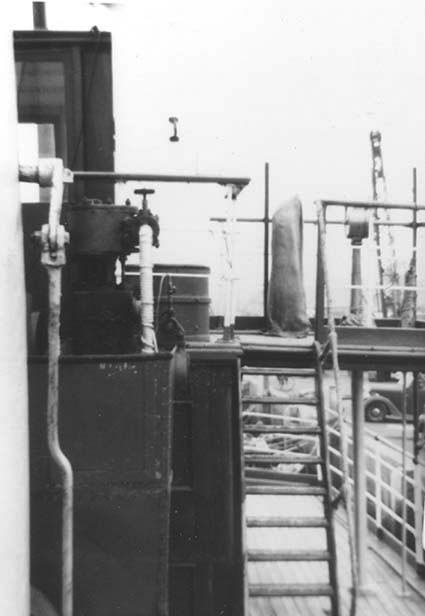
One little disadvantage though of the induced draught system was the fact that the fast moving steam engine for the fan on the Embassy chattered away to itself quite vigorously thereby making the adjacent wheelhouse vibrate. I recall Capt Defrates telling me that when he had been offered the choice of commanding either the Monarch or the Embassy prior to the 1960 season he had chosen the Monarch which, being coal-fired, was without this irritating accessory attached to the bridge.
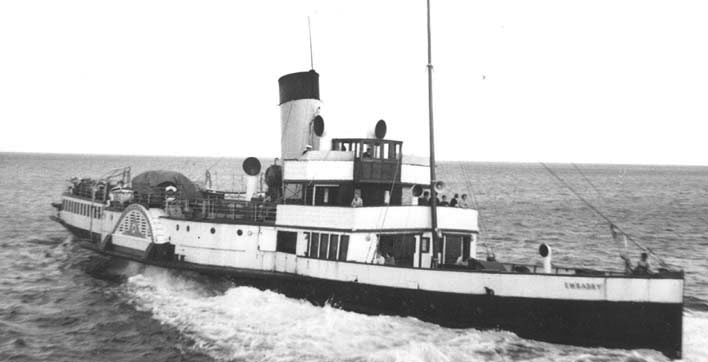
Overall, the Embassy was scheduled to sail on 93 operating days in 1965. The weather caused complete cancellations on four of these days in June and July, a further one day in August and another in September when the remnants of Hurricane Betsy passed up the channel so it was actually a good year with far fewer cancellations than was sometimes the case. However, there were some other days when the wind and swell at Bournemouth Pier caused further disruptions to the schedule and the Embassy sustained some damage to the deck of her port sponson in heavy seas on 23rd July on her outward passage from Bournemouth to Yarmouth.
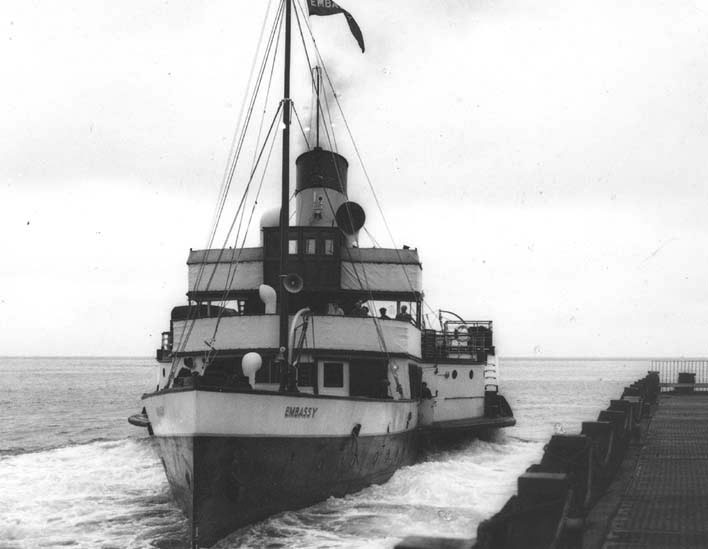
The Embassy’s last scheduled sailings of the season were were two round trips from Bournemouth to Totland Bay at 10.30am and 3.30pm with a coastal cruise from Bournemouth at 2.30pm thrown in on Thursday 23rd September.
It was Cosens general practice to end the Bournemouth season on a Thursday so that the paddlers could be put to bed in their Weymouth lay-up berths and the majority of crew paid off by the end of the Friday. Often they went back to Poole for the night after the Thursday sailings and set off for Weymouth the following morning but as the passage through the Town Bridge at Weymouth could not be done three or so hours either side of low water and as high water on Friday 24th September 1965 was at 8.20am the Embassy steamed straight back to Weymouth after her Thursday trips in 1965 to avoid too early a start the next morning. She arrived at the Weymouth Pleasure Pier, from which she had made her first cruise of the season on Saturday 5th June, at around 10pm.
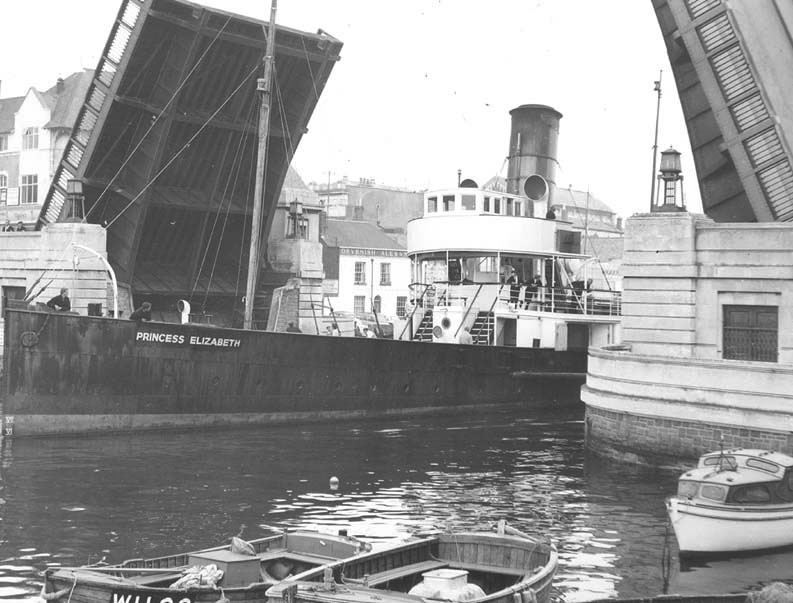
Earlier that same afternoon, my school-friends Richard Clammer and Richard Green and I, all aged 14, had joined the Princess Elizabeth on a rising tide at 4.15pm after school for her last trip of the season from the Pleasure Pier up the harbour and through the Town Bridge to her winter lay-up berth in the Backwater. You can see the two Richards leaning on the rails under the bridge with Capt Woods on the port bridge wing looking astern rather anxiously. He had decided to make the trip without the two boats usually made fast in the bow and the stern to help manoeuvring in the more confined waters up the harbour but as he passed through the bridge and saw the rather tight turn to starboard ahead with the plethora of yachts and fishing boats on both sides he was having second thoughts. There was no voice pipe on the Lizzie from the bridge to the engineer so someone had just been despatched below as his messenger to ask the engineer to make the slow ahead on the telegraph as slow as possible to allow the boats, which were following, to catch up and take lines. All went well and the Lizzie made fast in her berth and rang finished with engines at 4.45pm.

The following morning dawned overcast and, before school, we were all back on the Pleasure Pier to watch the Embassy cast off at 8.15am for the same trip up the harbour to her lay-up berth outside Cosens’s workshop where she made fast about 8.45am.
Our two local paddlers were home safe and sound for the winter.
Kingswear Castle returned to service in 2023 after the first part of a major rebuild which is designed to set her up for the next 25 years running on the River Dart. The Paddle Steamer Kingswear Castle Trust is now fund raising for the second phase of the rebuild. You can read more about the rebuilds and how you can help if you can here.
John Megoran

